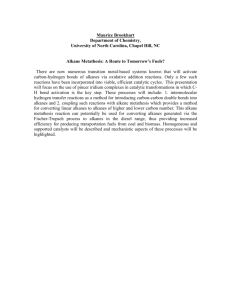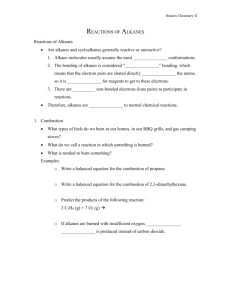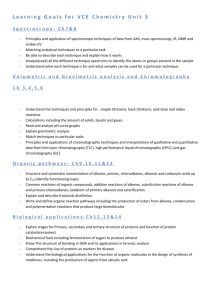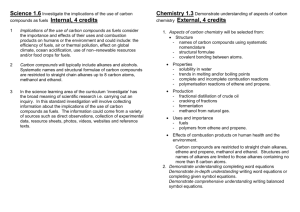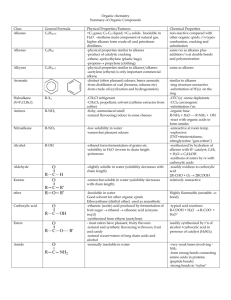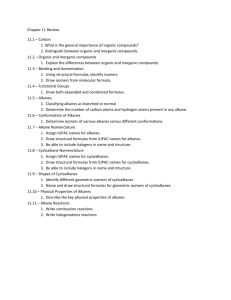Alkanes and Fuels - chemnotes.org.uk
advertisement
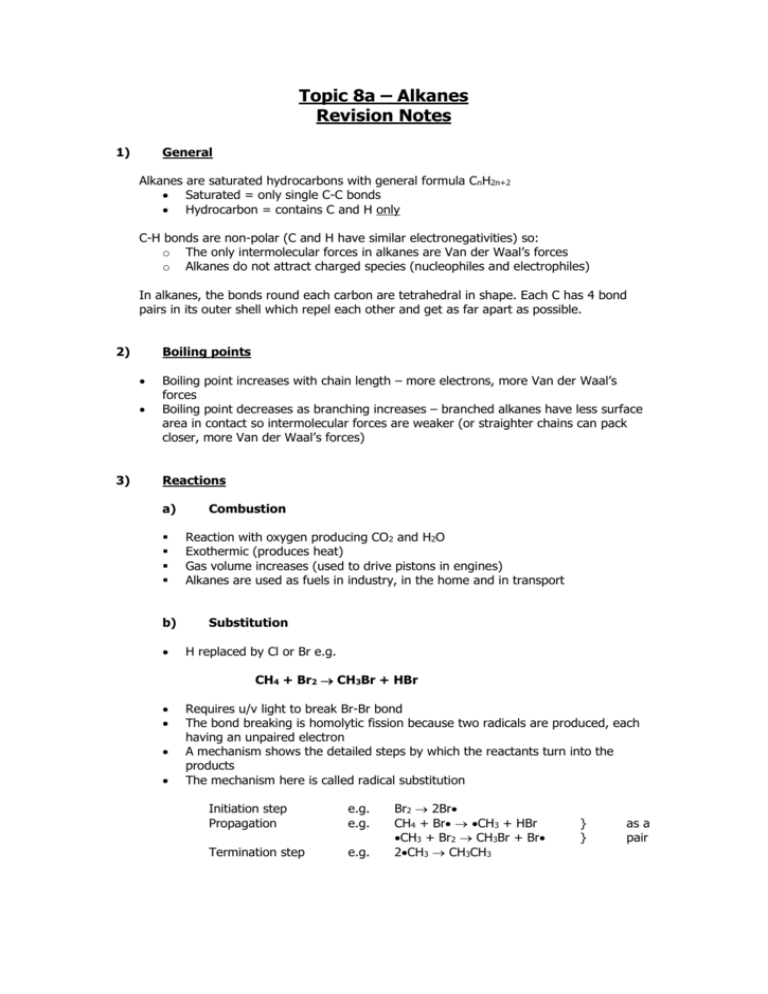
Topic 8a – Alkanes Revision Notes 1) General Alkanes are saturated hydrocarbons with general formula C nH2n+2 Saturated = only single C-C bonds Hydrocarbon = contains C and H only C-H bonds are non-polar (C and H have similar electronegativities) so: o The only intermolecular forces in alkanes are Van der Waal’s forces o Alkanes do not attract charged species (nucleophiles and electrophiles) In alkanes, the bonds round each carbon are tetrahedral in shape. Each C has 4 bond pairs in its outer shell which repel each other and get as far apart as possible. 2) Boiling points 3) Boiling point increases with chain length – more electrons, more Van der Waal’s forces Boiling point decreases as branching increases – branched alkanes have less surface area in contact so intermolecular forces are weaker (or straighter chains can pack closer, more Van der Waal’s forces) Reactions a) b) Combustion Reaction with oxygen producing CO2 and H2O Exothermic (produces heat) Gas volume increases (used to drive pistons in engines) Alkanes are used as fuels in industry, in the home and in transport Substitution H replaced by Cl or Br e.g. CH4 + Br2 CH3Br + HBr Requires u/v light to break Br-Br bond The bond breaking is homolytic fission because two radicals are produced, each having an unpaired electron A mechanism shows the detailed steps by which the reactants turn into the products The mechanism here is called radical substitution Initiation step Propagation e.g. e.g. Termination step e.g. Br2 2Br CH4 + Br CH3 + HBr CH3 + Br2 CH3Br + Br 2CH3 CH3CH3 } } as a pair Further substitution can occur with more H’s being replaced by Br’s CH3Br + Br2 CH2Br2 + HBr etc The reaction produces a mixture of products (CH 3Br, CH2Br2, CHBr3 and CBr4). This means that radical substitution is not a good way of making a particular product (the reaction has limited use in synthesis – which means making a desired product in a number of steps) Topic 8b – Fuels Revision Notes 1) Fractional Distillation 2) Crude oil is a mixture of many compounds, most of which are alkanes. Crude oil is separated into fractions, many of which can be used directly as fuels. The separation process is called fractional distillation. This involves: o Vaporising the crude oil o Passing the vapour into a column that is hot at the bottom and cool at the top o The vapour rising and condensing at the appropriate level o Separation is based on the different boiling points of alkanes Processing of fractions a) Cracking Crude oil contains no alkenes and more long chain alkanes than are needed. Cracking converts long chain alkanes into shorter chain alkanes and an alkene e.g. C11H24 C8H18 + C3H6 Cracking requires heat and a catalyst. It is a thermal decomposition reaction. The alkenes from cracking are used to make polymers and alcohols b) Isomerisation Isomerisation turns straight chain alkanes into branched chain alkanes e.g. Octane 2,2,4-trimethylpentane Branched chain hydrocarbons make better fuels as their lower boiling points mean they burn more efficiently Isomerisation increases the octane number of the hydrocarbon It needs a catalyst and heat c) Reforming Reforming turns straight chain alkanes into cyclic alkanes and arenes (and hydrogen) e.g. C6H14 C6H12 + H2 Hexane cyclohexane C6H14 Hexane Arenes contain a benzene ring (see A2 - Topic 1). Benzene can be represented in several ways. The third one will make more sense next year: Arenes make better fuels than straight chain alkanes as they have higher octane numbers and burn more efficiently Reforming needs heat and a catalyst 3) C6H6 + 4H2 benzene Fossil fuels and biofuels Fossil fuels (coal, gas and oil) are very useful to us as sources of energy and as a feedstock for making petrochemicals However, they are non-renewable as they take millions of years to form and increased CO2 levels from burning fossil fuels are leading to global warming and climate change We will eventually need to replace fossil fuels with renewable energy sources such as biofuels e.g. alcohol made from sugar cane and biodiesel made from grain Biofuels are renewable as plant material takes only a short time to grow
